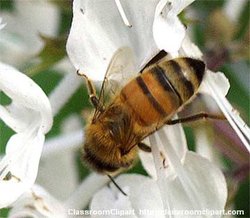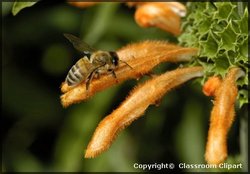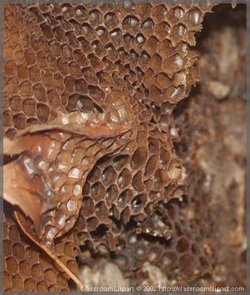Bee
|
|
| Bees | ||||||||||||
|---|---|---|---|---|---|---|---|---|---|---|---|---|
| Missing image Osmia_ribifloris_bee.jpg Osmia ribifloris Osmia ribifloris | ||||||||||||
| Scientific classification | ||||||||||||
| ||||||||||||
| Families | ||||||||||||
|
Andrenidae |
Bees (Apoidea superfamily) are flying insects, closely related to wasps and ants. They are adapted for feeding on nectar, and play an important role in pollinating flowering plants, and are called pollinators. Bees have a long proboscis that they use in order to obtain the nectar from flowers. Bees have antennae made up of thirteen segments in males and twelve in females. They have two pairs of wings, the back pair being the smaller of the two.
Bees are fuzzy and carry an electrostatic charge, thus aiding in the adherance of pollen. Bees periodically stop foraging and groom themselves to pack the pollen into specialized pollen baskets which are on the legs of honeybees and some other species, and on the ventral abdomen on other species. Some of this pollen is carried from flower to flower, but the bulk of it is carried back to the nest to feed brood. The apex of the female abdomens are modified into a stinger.
There are over 16,000 described species, and possibly around 30,000 species in total. Bees may be solitary, or may live in various sorts of communities. The most advanced of these are eusocial colonies, found among the honeybees and stingless bees. Sociality is believed to have evolved separately in different groups of bees.
| Contents |
Bees and Bee Hives
Bees live in large hives, each of which has a single queen, together with workers and drones. Honeybees are eusocial.
Bumblebees are referred to a quasisocial because the queen bee is typically able to survive on her own for at least a short time (unlike queens in eusocial species who must be cared for at all times).
The life cycle of bumblebees begins in the spring when the queen bee rises from hibernation. At this time the queen bee is the one who does all the work because there are no worker bees to do the work yet. She searches for a place to build her nest and she builds the honeypots. She also does the foraging to collect nectar and pollen. Bumblebee colonies die off in the autumn, after raising a last generation of queens, which survive individually in found hiding spots. Interestingly bumblebee queens sometimes seek winter safety in honeybee hives, where they are sometimes found dead in the spring by beekeepers, presumably stung to death by the honeybees. It is not known whether any succeed in winter survival in such an environment.
Bumblebees also form colonies, but with fewer individuals than honeybees. Most species of bumblebee (Bombus terrestris, B. pratorum, et al.) live in colonies of 30-400 bees. (By contrast, an average honeybee hive at the height of summer will have 30,000 - 50,000 bees.)
With honeybees, which survive winter as a colony, the queen begins egg laying in mid to late winter, to prepare for spring. This is probably triggered by day length. She is the only fertile female, and deposits all the eggs from which the other bees are produced. Except for her one mating flight or to establish a new colony, the queen rarely leaves the hive after the larvae have become full grown bees. The queen deposits each egg in a cell prepared by the worker bees. The egg hatches into a small larva which is fed by nurse bees (worker bees who maintain the interior of the colony). After about a week (depending on species), the larva is sealed up in its cell by the nurse bees. After another week (again, depending on species), it will emerge an adult bee.
The larvae and pupae in a frame of honeycomb are referred to as frames of brood and are often sold (with adhering bees) by beekeepers to other beekeepers to start new beehives.
Both workers and queens are fed royal jelly during the first three days of the larval stage. Then workers are switched to a diet of pollen and nectar or diluted honey, while those intended for queens will continue to receive royal jelly. This causes the larva to develop to the pupa stage more quickly, while being also larger and fully developed sexually. Queen breeders consider good nutrition during the larval stage to be of critical importance to the quality of the queens raised, good genetics and sufficient number of matings also being factors. During the larval and pupal stages, various parasites can attack the pupa/larva and destroy or damage it.
Queens are not raised in typical horizontal brood cells of the honeycomb. They are specially constructed to be much larger, and have a vertical orientation. As the queen finishes her larval feeding, and pupates, she moves into a head downward position, from which she will later chew her way out of the cell. At pupation the workers cap or seal the cell. Just prior to emerging from their cells, young queens can often be heard "piping." This is considered likely to be a challenge to other queens for battle.
Worker bees are infertile females. Worker bees secrete the wax used to build the hive, clean and maintain the hive, raise the young, guard the hive and forage for nectar and pollen. In honeybees, the worker bees have a modified ovipositor called a stinger with which they can sting to defend the hive, but the bee will die soon after.
Drone bees are the male bees of the colony. Drone honeybees do not forage for nectar or pollen. The primary purpose of a drone bee is to fertilize a new queen. Drones mate with the queen in flight. They die immediately after mating.
In some species, drones are suspected of playing a contributing role in the temperature regulation of the hive. Drone bees have no stinger, since a stinger is actually a modified ovipositor.
Queens live for an average of three years, while workers have an average life of only three months (during the foraging season, but longer in places with extended winters).
Honeybee queens release pheromones to regulate hive activities, and worker bees also produce pheromones for various communications.
Honey is produced from nectar collected from flowers, which is a clear liquid consisting of nearly 80% water with complex sugars. The collecting bees store the nectar in a second stomach and return to the hive where worker bees remove the nectar. The worker bees digest the raw nectar for about 30 minutes using enzymes to break up the complex sugars into simpler ones. Raw honey is then spread out in empty honeycomb cells to dry, which reduces the water content to less than 20%. When nectar is being processed, honeybees create a draft through the hive by fanning with their wings. Once dried, the cells of the honeycomb are sealed (capped) with wax to preserve the honey.
Honey itself is so sweet that bacteria cannot grow on it, and dry enough that it does not support yeasts. Anaerobic bacteria may be present and survive in spore form, in honey, as well as anywhere else in common environments. Honey (or any other sweetener) which is diluted by the non-acidic digestive fluids of infants, can provide an ideal medium for the transition of botulism bacteria from the spore form to the actively growing form, which produces a toxin. When infants are weaned to solid foods, their digestive system becomes acid enough to prevent such growth and poisoning. No sweeteners should be given to infants prior to weaning, as there is a small, but possibly lethal risk of poisoning.
Honeybee pheromones
Honeybees use special pheromones, or chemical communication, for almost all behaviors of life. Such uses include (but are not limited to): mating, alarm, defense, orientation, kin and colony recognition, food production, and integration of colony activities. Pheromones are thus essential to honeybees for their survival.
Solitary, and communal bees
Other species of bee such as the Orchard Mason bee (Osmia lignaria) and the hornfaced bee (Osmia cornifrons) are solitary in that every female is fertile. There are no worker bees for these species. Solitary bees typically produce neither honey nor beeswax. They are immune from acarine and varroa mites, but have their own unique parasites, pests and diseases. (see diseases of the honeybee)
Kleptoparasitic bees
Cuckoo bees are bumblebee look-alikes that invade bumblebee nests and lay their eggs. The bumblebees raise the young as their own. Megachilid bees also have other megachilid Coelioxys bees whose young are placed into the already provisioned nests of these solitary bees. They destroy the host larvae and eat the food.
Communication
- "The general story of the communication of the distance, the situation, and the direction of a food source by the dances of the returning worker bee on the vertical comb of the hive, has been known in general outline from the work of Karl von Frisch in the middle 1950s." The dance involve a returning bee running around in a tight figure of eight dance, waggling its abdomen as it does so. All the other bees gather around, apparently scrutinising the ceremonial manoeuvre. (World&I) (http://www.worldandi.com/subscribers/feature_detail.asp?num=24297)
Miscellaneous
All bees eat nectar and pollen. Bees are excellent pollinators and play an important role in agriculture. The largest bee in the world is the Megachile pluto. Bees are the favorite meal of Merops apiaster, a bird.
See also
- Africanized bee
- Bee anatomy (mouth)
- Bee learning and communication
- Honeybee
- Honeybee life cycle
- Characteristics of common wasps and bees
- Beekeeping
Animal Pictures and Photographs
- Clipart (http://classroomclipart.com/clipart/Clipart.htm)
- Animal Clipart (http://classroomclipart.com/clipart/Clipart/Animals.htm)
- Animal Animated Clipart (http://classroomclipart.com/clipart/Animations/Animals.htm)
- Pictures of Animals (http://classroomclipart.com/clipart/Animals.htm)
- Amphibian Clip Art, Pictures and Photographs (http://classroomclipart.com/clipart/Animals/Amphibians.htm)
- Farm Animal Clip Art, Pictures and Photographs (http://classroomclipart.com/clipart/Animals/Farm_Animals.htm)
- Mammal Clip Art, Pictures and Photographs (http://classroomclipart.com/clipart/Animals/Mammals.htm)
- Marine Animal Clip Art, Pictures and Photographs (http://classroomclipart.com/clipart/Animals/Marine_Life.htm)
- Reptile Clip Art, Pictures and Photographs (http://classroomclipart.com/clipart/Animals/Reptiles.htm)
- Spider Clip Art, Pictures and Photographs (http://classroomclipart.com/clipart/Animals/Spiders.htm)
- Assortment of Videos (http://classroomclipart.com/clipart/Videos.htm)
- Animal Videos (http://classroomclipart.com/clipart/Videos/Animals.htm)




